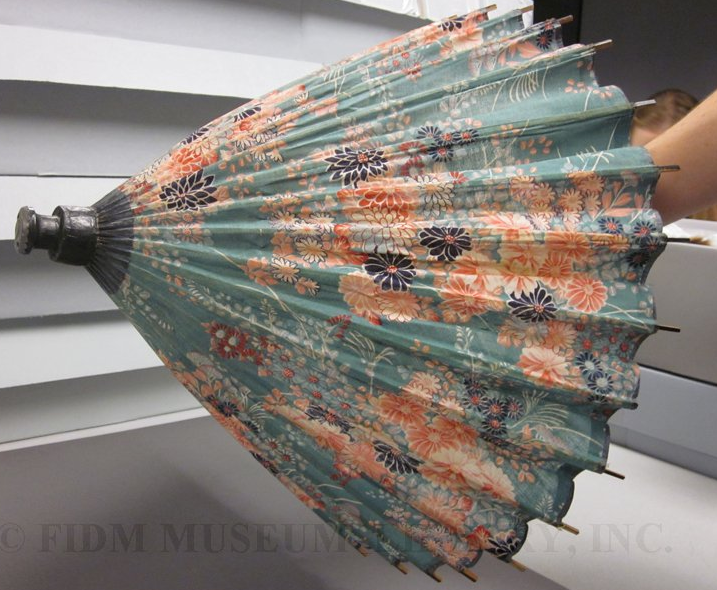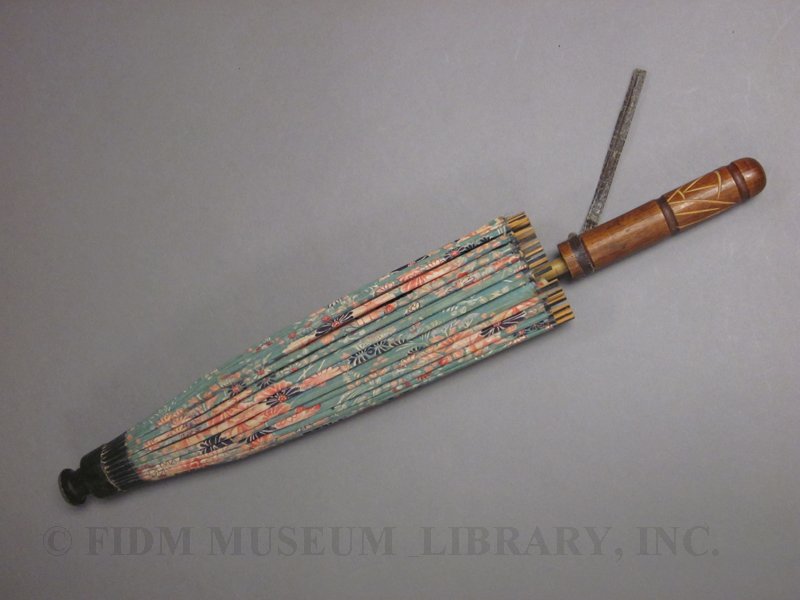Two women posed for this casual outdoor snapshot, c. 1911. Their nearly identical ensembles of short-sleeved middy blouses and ankle-length skirts suggest summertime leisure. Though popular as school uniforms for children,
middy blouses were also worn as women’s sportswear. The
loose fit made swinging a racket or holding an oar much easier, and also set
the mood for watching spectator sports. The slight rumpling of their
middy blouses suggests these women have recently engaged in some kind of sporting
activity. The parasols add a colorful accent to these casual ensembles.
 Snapshot
Snapshot
c. 1911
Gift of Kathryn Alessio Estate
A brief notation on the back of the snapshot gives us a clue to the setting: Saugunuk, Michigan, Camp Elinor, 1911. Saugunuk is probably a misspelling of Saugatuck, a town located on the Kalamazoo River, and not far from
the shores of Lake Michigan. Research didn't reveal any information about Camp
Elinor, but it was probably a summer camp or resort in, or near,
Saugatuck. By the late 1890s, Saugatuck was a lively summer destination,
attracting visitors from Chicago, St. Louis and other nearby cities. In
1909, just a few years before this photo was taken, Saugatuck investors built the
Big Pavilion, an enormous hall
used for dances, concerts, and other special events. The Big Pavilion cemented
Saugatuck’s status as a fashionable destination. Given their casual attire and the outdoor setting, the
two women pictured in this photo were probably enjoying a relaxed summer vacation
in Saugatuck.
A printed cotton parasol was donated along with this c. 1911 image. The donor believed that the parasol might be one of the two pictured in the snapshot. Though we can't be sure, it's a very similar style. An important accessory, parasols were very much in vogue during this period. In addition to providing protection from the sun, colorful parasols added that little something extra to a summer ensemble. And, as Vogue noted in 1916, parasols had "one undeniable advantage–they keep one out in the open air."1
 Parasol
Parasol
c. 1909-1919
Gift of Kathryn Alessio Estate
2010.813.2
With a "Made in Japan" label encircling the tip, our printed cotton parasol was definitely made for export. Because of their typically bright colors, and relatively low cost, Japanese-made paper or cotton umbrellas were often used as parasols. Unlike costly silk parasols, these parasols were a practical choice for the beach, and other holiday destinations. A 1919 Vogue article on beach accessories highlighted the price difference: a silk pongee parasol cost $10.55 (including a 55 cent luxury tax!), while a Japanese paper parasol was listed at $1.50. The same article noted that a 4.5 foot wide Japanese umbrella, listed at $2.50, would make a perfect beach umbrella.
1 "Fashion: The Shady Side of Things." Vogue (Aug 15, 1916): 76.
2 "Fashion: Suits and Accessories for Bathing." Vogue (Jun 15, 1919): 62.



Fashions from late 1890 early 1900’s always interest me, with their lavish accessories and beautiful designs. As a restorer of old photos i come across quite a few interesting outfits and accessories. Mourning dresses were also very elaborate and no doubt very expensive too. It must have a very expensive business when someone died!